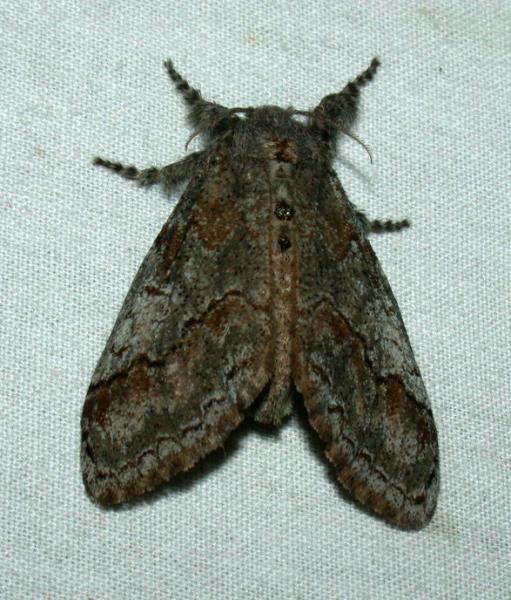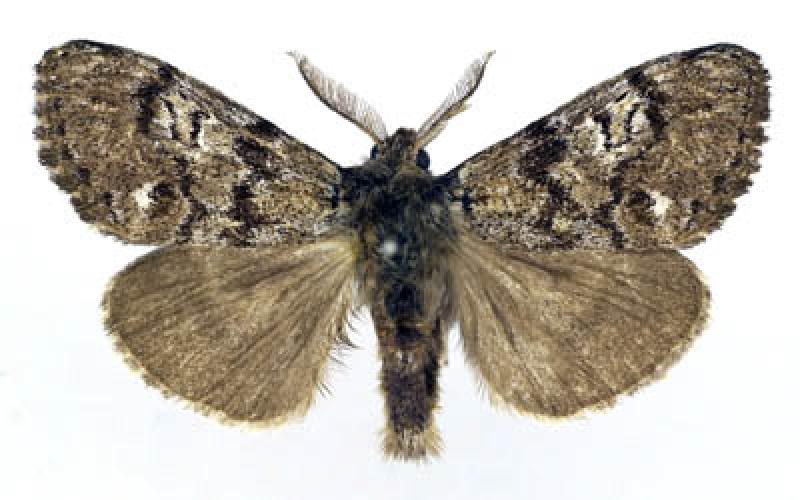Pine Tussock Moth
Dasychira pinicola (Dyar, 1911)
- Class
- Insecta (Insects)
- Family
- Erebidae
- State Protection
- Not Listed
Not listed or protected by New York State.
- Federal Protection
- Not Listed
- State Conservation Status Rank
- SU
Unrankable - Currently unrankable due to lack of information or due to substantially conflicting information about status or trends.
- Global Conservation Status Rank
- G4
Apparently Secure globally - Uncommon in the world but not rare; usually widespread, but may be rare in some parts of its range; possibly some cause for long-term concern due to declines or other factors.
Summary
Did you know?
Tussock moth caterpillars often are covered with tufts of red, yellow, and black hair. As in other caterpillars, such colors warn of danger. Many people are allergic to the body hair of tussock moth caterpillars, especially if the hairs are brought into contact with eyes or sensitive areas of skin (Wagner et al. 1997).
State Ranking Justification
Currently, in New York State, the Pine Tussock Moth is known from only one location- the dwarf pine plains on Long Island. This species feeds on the foliage of pitch pine, which is the dominant tree species in that area.
Short-term Trends
This species appears to be relatively stable over the past decade. The presence of this species over multiple years at the dwarf pine plains site on Long Island indicates that the population is viable and reproducing. There was a significant increase in population numbers in 2005 in areas that were unburned by the large forest fire of 1995. This species requires pitch pine forests or woodlands rather than pitch pine-scrub oak barrens that dominate a landscape after an intense fire such as the forest fire in 1995.
Long-term Trends
The long-term trend for this species is tied to the long-term trend of the natural community it lives in. The acreage of dwarf pine plains in New York has declined from development, although there is still a large occurrence of this habitat type on Long Island.
Conservation and Management
Threats
Known threats include habitat loss due to development and fire suppression, although the threat of development for the remaining habitat on Long Island may be low. The suppression of fires in pitch pine forests and woodlands would cause a loss of habitat for the species and therefore a reduction in population size. This species requires pine forests or woodlands to exist. Forest fires are needed to maintain this type of habitat on Long Island. To maintain a pitch pine type forest, moderate intensity fires (not high intensity fires) are needed, on average, every 10-20 years (Jordan et al. 2003). Lack of forest fires will result in the succession of this community to a closed-canopy forest of tall oaks and other hardwoods (Little 1979, Jordan et al. 2003). Conversely, a fire affecting an entire occurrence could eliminate all life stages that are present.
Conservation Strategies and Management Practices
The best management strategy for this species is the management of the natural community, or habitat, where this species occurs. Maintaining the Long Island pine barrens with their full suite of plant and animal species requires frequent (every few decades) disturbance to maintain the pitch pine-oak forest and to prevent succession to a closed-canopy hardwood forest (Jordan et al. 2003). Researchers have determined that "an active fire management program utilizing prescribed fire with appropriate mechanical treatments" is the preferred method (Jordan et al. 2003). Researchers have also determined that the size, type, intensity, and timing of fires (pyrodiversity) needs to be evaluated for each site to maximize benefits to the natural community and the species it supports (Jordan et al. 2003). The pitch pine-oak forest community, where this moth occurs, requires moderate intensity fires. The entire occupied habitat for a population should not be burned in a single year. For example, in places where prescribed burning is used, refugia (unburned areas) are needed for many species to ensure that any life stage can survive a fire.
Research Needs
Additional surveys are needed with blacklight traps to determine the extent of the dwarf pine plains occurrence on Long Island and locate additional occurrences. In addition, research is needed on the response of this species to prescribed (controlled) burning and mechanical treatment to improve habitat.
Habitat
Habitat
In New York State, the Pine Tussock Moth is only found in the pitch pine woodlands and barrens of Long Island.
Associated Ecological Communities
- Dwarf pine plains
(guide)
A woodland community dominated by dwarf individuals of pitch pine and scrub oak that occurs on nearly level outwash sand and gravel plains in eastern Long Island. The soils are infertile, coarse textured sands that are excessively well-drained.
Associated Species
- Burgess's Apamea (Apamea burgessi) (guide)
- Herodias Underwing (Catocala herodias)
- Jair Underwing (Catocala jair)
- Melsheimer's Sack Bearer (Cicinnus melsheimeri) (guide)
- Packard's Lichen Moth (Cisthene packardii) (guide)
- Projecta Gray (Cleora projecta) (guide)
- A Geometrid Moth (Euchlaena madusaria) (guide)
- Fringed Dart (Eucoptocnemis fimbriaris) (guide)
- Violet Dart (Euxoa violaris) (guide)
- Coastal Barrens Buckmoth (Hemileuca maia ssp. 5) (guide)
- Yellow-spotted Graylet (Hyperstrotia flaviguttata) (guide)
- Pale Green Pinion Moth (Lithophane viridipallens) (guide)
- Pin-striped Slug Moth (Monoleuca semifascia) (guide)
- Gray Woodgrain (Morrisonia mucens) (guide)
- Pink Sallow (Psectraglaea carnosa) (guide)
- Spinose Flower Moth (Schinia spinosae) (guide)
- Barrens Itame (Speranza exonerata) (guide)
- Toothed Apharetra (Sympistis dentata) (guide)
- Orange Holomelina (Virbia aurantiaca) (guide)
- Pine Barrens Zale (Zale lunifera) (guide)
Range
New York State Distribution
This species is confined to Long Island and its vicinity (Schweitzer 1998).
Global Distribution
Data on the global distribution of the Pine Tussock Moth is not well documented. It is known from Massachusetts, New York, Virginia, and Ontario (NatureServe 2010). Although it is rare in New York, it is considered a pest species in Minnesota, where it is responsible for the defoliation of jack pine forests (H. McGuinness, personal communication).
Best Places to See
- Dwarf Pine Plains (Suffolk County)
Identification Comments
Identifying Characteristics
This species can be identified from a specimen or a good image. Moths are dark gray-brown with thin black lines on the veins. The larvae are gray-brown as well with four tufts of grayish hairs on the back.
Diet
The larvae of this species feed exclusively on pine foliage.
Best Time to See
The adult moths of this species are active throughout the summer in pitch pine woodlands and barrens.
- Present
- Reproducing
The time of year you would expect to find Pine Tussock Moth present and reproducing in New York.
Pine Tussock Moth Images
Taxonomy
Pine Tussock Moth
Dasychira pinicola (Dyar, 1911)
- Kingdom Animalia
- Phylum Arthropoda
(Mandibulates)
- Class Insecta
(Insects)
- Order Lepidoptera
(Butterflies, Skippers, and Moths)
- Family Erebidae
- Order Lepidoptera
(Butterflies, Skippers, and Moths)
- Class Insecta
(Insects)
- Phylum Arthropoda
(Mandibulates)
Comments on the Classification
Forbes (1948) lumps this species in with Dasychira pini.
Additional Resources
References
Forbes, William T. M. 1948. Lepidoptera of New York and neighboring states part II. Cornell University Agricultural Experiment Station Memoir 274.
Jordan, M. J., W. A. Patterson III, A. G. Windisch. 2003. Conceptual ecological models for the Long Island pitch pine barrens: implications for managing rare plant communities. Forest Ecology and Management 185, 151-168.
Little, S. 1979. Fire and plant succession in the New Jersey pine barrens. pp. 297-313 in Forman, R.T.T. (ed.) Pine Barrens: Ecosystem and Landscape. Academic Press, Inc. Orlando, FL.
McGuinness, Hugh D. 2009. Moths of fire: a study of the macro-lepidoptera in burned and unburned plots at the New York State Department of Environmental Conservation's Sarnoff Preserve in Flanders, Suffolk County, New York. 2006-2008. Report for the Long Island Chapter of The Nature Conservancy.
McGuinness, Hugh. 2006. Overview of the 2005 Dwarf Pine Plains data.
NatureServe. 2010. NatureServe Explorer: An online encyclopedia of life [web application]. Version 7.1. NatureServe, Arlington, Virginia. Available http://www.natureserve.org/explorer. (Data last updated August 2010)
New York Natural Heritage Program. 2024. New York Natural Heritage Program Databases. Albany, NY.
North American Moth Photographers Group at the Mississippi Entomological Museum. No date. Mississippi State University, Mississippi. http://mothphotographersgroup.msstate.edu/MainMenu.shtml
Opler, Paul A., Kelly Lotts, and Thomas Naberhaus, coordinators. 2010. Butterflies and Moths of North America. Bozeman, MT: Big Sky Institute. <http://www.butterfliesandmoths.org/> (accessed May 2010).
Schweitzer, Dale F. 1998. Rare, potentially rare, and historic macrolepidoptera for Long Island, New York: A suggested inventory list.
Wagner, D.L., V. Giles, R.C. Reardon, and M.L. McManus. 1997. Caterpillars of eastern forests. USDA, Forest Service, Forest Health Technology Enterprise Team, FHTET-96-34, Washington, DC. 113 pp.
Links
About This Guide
This guide was authored by: Lauren Lyons-Swift
Information for this guide was last updated on: December 21, 2011
Please cite this page as:
New York Natural Heritage Program. 2024.
Online Conservation Guide for
Dasychira pinicola.
Available from: https://guides.nynhp.org/pine-tussock-moth/.
Accessed April 18, 2024.

